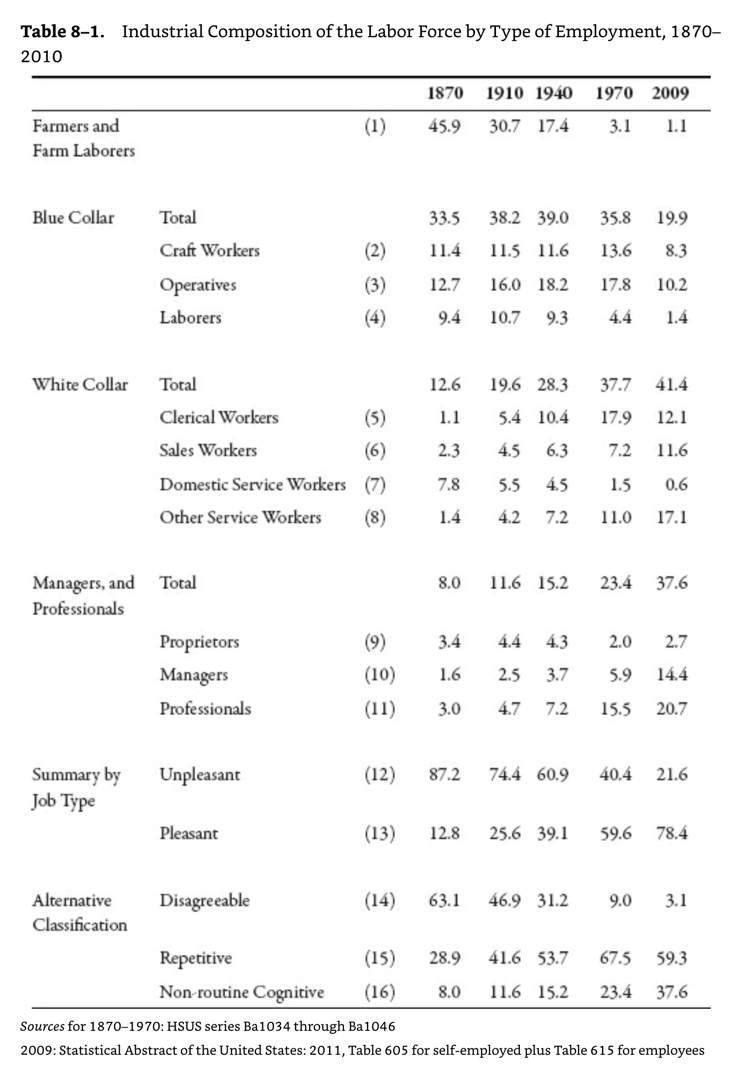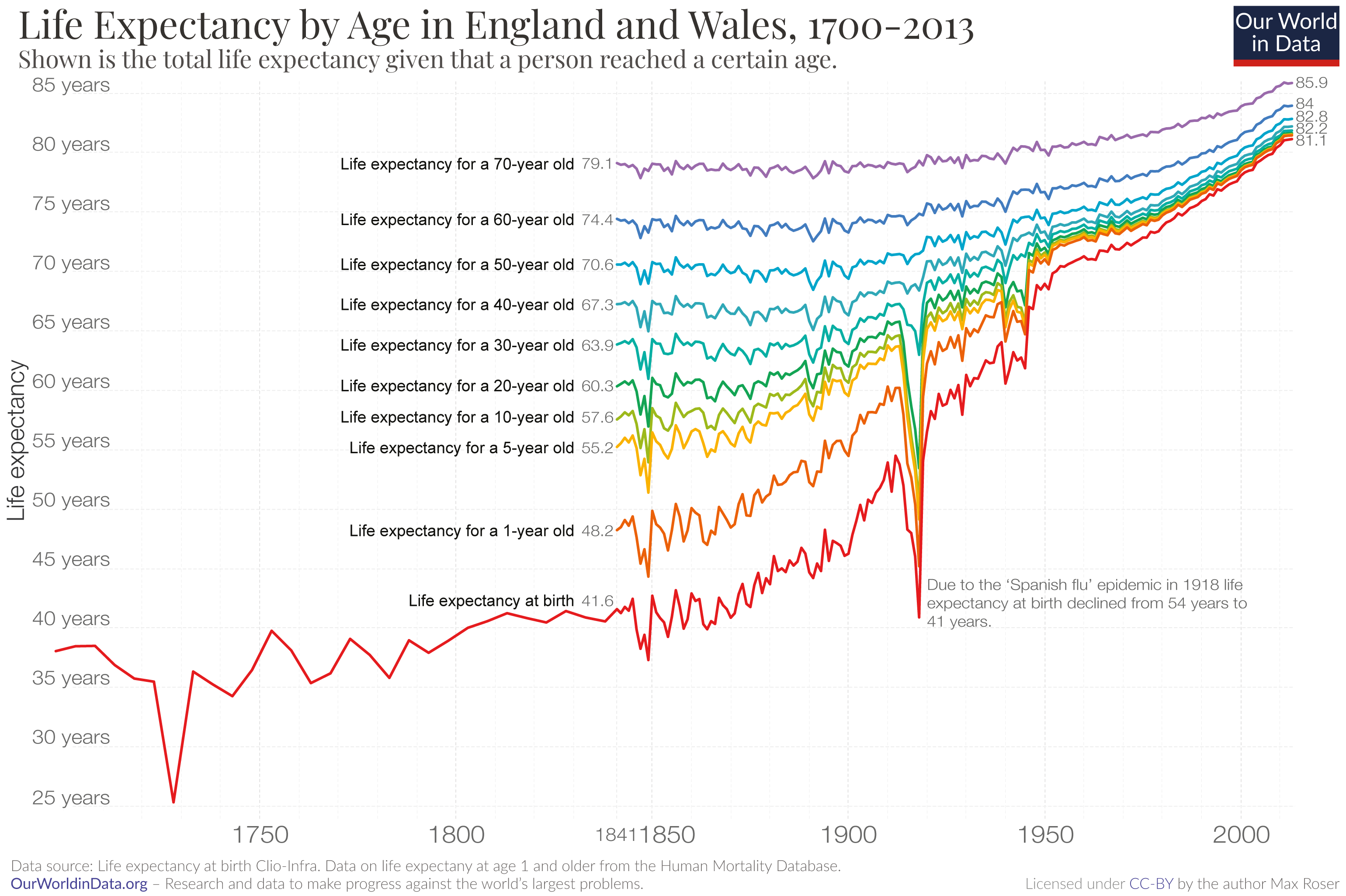Why didn't we get the four-hour workday?
Or the two-hour day, or the sixteen-hour week, or other predictions
by Jason Crawford · January 6, 2023 · 6 min read
John Maynard Keynes famously predicted in 1930 that by now we would only be working fifteen hours a week. What is less well-known is that his was nowhere near the only such prediction, nor the first—a wide range of commentators, including Charles Steinmetz and Buckminster Fuller, made similar forecasts. (And even Keynes’s prediction is generally misquoted.)
Why didn’t any of them come true? I recently discussed this with Jason Feifer on his podcast Build for Tomorrow. Here’s some elaboration with more quotes and charts.
The predictions
A 1934 book, The Economy of Abundance, summarizes many of the predictions (Chapter 2):
The technocrats promised every family on the continent of North America $20,000 a year [about $400,000 today], and a sixteen-hour work week. This is perhaps the peak of promises based on an abundance economy. Charles P. Steinmetz saw a two-hour working day on the horizon—he was the scientist who made giant power possible—but he stipulated no family budget total beyond “necessities and comforts.” …
Fred Henderson, in his Economic Consequences of Power Production, is more specific: “Without any further increase in our knowledge of power and of technical processes, or of our available materials, we could multiply production ten times over if the needs of the world were permitted to express themselves in effective demand. … It would not be a question of an eight-hour day or a six-day week, but more probably of a six-months working year—which is already the rule for university dons.”
Buckminster Fuller is still more definite. Modern man, he calculates, is 630 times more able than was Adam. Eliminating wasteful forms of work, four million Americans laboring fifty-two seven-hour days in the year (364 working hours, an average of one per day) “could keep up with every survival need”—meaning basic necessities for the whole population.
Walter N. Polakov announces that “fifty weeks, four days, six hours is enough”—a twenty-four hour week and two weeks’ vacation…
Harold Rugg in The Great Technology estimates a possible minimum living standard between ten- and twenty-fold greater than the minimums of 1929, on a sixteen- to twenty-hour work-week. …
One can continue to cite such evidence indefinitely. Fortunately, A. M. Newman has been collecting it for years and saves us the trouble by the following summary: “Among them [such estimates] a substantial agreement is found that by better use of the mechanical facilities at our disposal we could produce many times our present supply of goods at considerably less effort.” The five-hour day tends to be the maximum estimate in Mr. Newman’s collection.
As for Keynes, his essay “Economic Possibilities for our Grandchildren” wasn’t even saying that a fifteen-hour work week would be necessary for production. He thought it would be necessary to satisfy our psychological need for work, implying that our physical needs could be satisfied with less (exactly how much less, he doesn’t estimate):
For many ages to come … everybody will need to do some work if he is to be contented. We shall do more things for ourselves than is usual with the rich today, only too glad to have small duties and tasks and routines. But beyond this, we shall endeavour to spread the bread thin on the butter—to make what work there is still to be done to be as widely shared as possible. Three-hour shifts or a fifteen-hour week may put off the problem for a great while.
Why is the 40-hour work week still standard?
Here are my hypotheses (not mutually exclusive):
The predictions got the elasticity wrong
When labor gets more productive, workers can choose to work less for the same real wage, to make more money by working the same amount, or something in between.
Most of these predictions (if they were meant as predictions—see below) basically assumed the former: that living standards would stay constant, and working hours would be reduced. But as inventions like electricity and the assembly line were boosting labor productivity, inventions like the washing machine and the automobile were improving personal life. Workers wanted to earn more than they used to, to buy all the new products that were just becoming available. Some of the excess labor productivity was used to produce, and to consume, these new goods, rather than all of it going to increased leisure.
And as Jason Feifer pointed out on the podcast, even the new leisure itself required new goods and services to make the most of it, such as sports equipment or flights to vacation destinations.
Work got better
There was a shift from physical labor in farms and factories to mental labor in offices, and from routine work to more mentally challenging work.
Robert Gordon documents this in The Rise and Fall of American Growth. In 1910, 47% of US jobs were what Gordon classifies as “disagreeable” (farming, blue-collar labor, and domestic service), and only 8% of jobs were “non-routine cognitive” (managerial and professional). By 2009, only 3% of jobs were “disagreeable” and over 37% were “non-routine cognitive”:

This partly explains why, when NPR’s Planet Money set out to check on Keynes’s prediction in 2015, they found people who claimed they worked 50 to 100 hours per week—they were a psychotherapist and a university professor.
Working hours did decrease significantly
Just not as much as some predicted. A 70-hour work week, spread over six days, was once common. Now in France and Spain the average is around 35 hours:
And we got more vacation and holiday time as well:
Total lifetime working hours decreased even more
As family incomes grew, and as social ideas of childhood evolved, child labor waned, and children stayed more years in school.
On the other end of life’s timeline, retirement was invented. Robert Gordon explains:
In the pre-1920 era, there was no concept of “retirement.” Workers “worked until they dropped”—that is, they kept working until they were physically unable to do their jobs, after which they became dependent on their children, or on church charity and other kinds of private welfare programs.
Rising incomes enabled the creation of retirement, which can be seen in falling labor participation rates of older men:
But it gets better—life expectancy was also rising, meaning people had more years of life to actually enjoy their retirement. Here’s a chart to show this—it’s data from England and Wales, but I chose it here to show that the increases were not only in life expectancy at birth, but at older ages as well. For instance, someone retiring at age 60 in 1920 could expect about fifteen more years; by 2013 another nine years had been added to that:

Putting this all together, Nicholas Crafts came up with these estimates for expected lifetime hours of work for men aged 20:
| Year | Work hours | Other hours |
|---|---|---|
| 1881 | 114,491 (49%) | 119,269 (51%) |
| 1951 | 94,343 (33%) | 191,429 (67%) |
| 2011 | 70,612 (20%) | 276,522 (80%) |
A reduction from 49% of an adult life spent working to 20% is almost as great as a reduction from forty hours a week to fifteen.
There is a psychological value to work
People don’t need infinite leisure. They need things to do. Keynes had this right when he said that “everybody will need to do some work if he is to be contented.”
Economist Paul Romer went to Burning Man and pointed out:
… if you ask, what do people do if you put them in a setting where there’s supposed to be no compensation, no quid pro quo, and you just give them a chance to be there for a week. What do they do?
They work.
How seriously were these predictions meant?
A careful reading of The Economy of Abundance, however, makes me wonder whether these estimates were seriously meant as predictions. An alternate interpretation is that they were just illustrations of the potential for productive capacity.
Elided from the block quote above are other estimates, not of the potential for a shorter working week or year, but of how much the production of industry could be increased. For instance:
“It is an open secret,” said Thorstein Veblen in 1919, “that with a reasonably free hand the production experts could readily increase the ordinary output of industry by several fold—variously estimated at some 300 to 1200 percent.”
Veblen was an early promoter of technocracy as an industrial philosophy; I mentioned him in my review of American Genesis. Or take this, which the book attributes to J. A. Hobson:
With existing plant and power, and natural resources, labor and managerial knowledge, the world could produce at least twice as much wealth per capita as it is actually producing, without undue strain upon human energy.
These productivity increases weren’t supposed to come from advanced technology—they were to come from better organization and “scientific management.” The Economy of Abundance was written by Stuart Chase, an economist who coined the term “New Deal.” Ultimately, Chase was arguing that capitalism was wasteful and inefficient, and that with centralized government control, the waste could be eliminated. He cited an earlier study of his that had found millions of workers’ worth of manpower wasted on inefficient production, on distribution, and on “vicious goods and services.” He suggested that “an Industrial General Staff” appointed by the President to direct the economy could double the standard of living.
So it’s not clear how much people actually expected a sixteen-hour work week or whatever. Some of them might have just been saying that productivity could be much higher, regardless of whether that turned into shorter working hours, higher wages, or a combination of both—and regardless of whether they saw that as a miracle of capitalism, or a condemnation of it.
